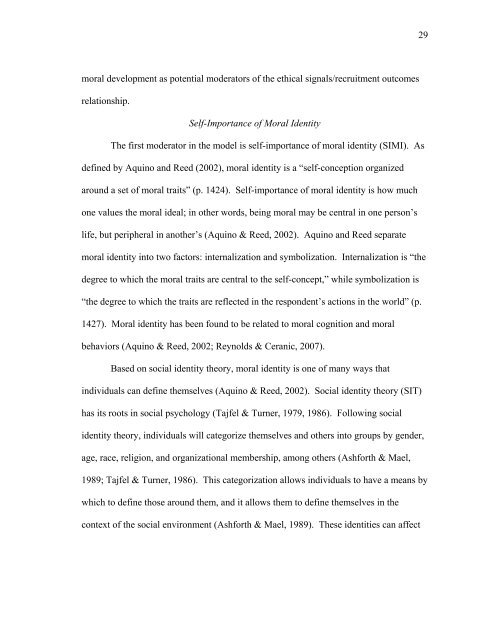THE EFFECT OF ETHICAL SIGNALS ON RECRUITMENT ...
THE EFFECT OF ETHICAL SIGNALS ON RECRUITMENT ...
THE EFFECT OF ETHICAL SIGNALS ON RECRUITMENT ...
You also want an ePaper? Increase the reach of your titles
YUMPU automatically turns print PDFs into web optimized ePapers that Google loves.
moral development as potential moderators of the ethical signals/recruitment outcomes<br />
relationship.<br />
Self-Importance of Moral Identity<br />
The first moderator in the model is self-importance of moral identity (SIMI). As<br />
defined by Aquino and Reed (2002), moral identity is a “self-conception organized<br />
around a set of moral traits” (p. 1424). Self-importance of moral identity is how much<br />
one values the moral ideal; in other words, being moral may be central in one person’s<br />
life, but peripheral in another’s (Aquino & Reed, 2002). Aquino and Reed separate<br />
moral identity into two factors: internalization and symbolization. Internalization is “the<br />
degree to which the moral traits are central to the self-concept,” while symbolization is<br />
“the degree to which the traits are reflected in the respondent’s actions in the world” (p.<br />
1427). Moral identity has been found to be related to moral cognition and moral<br />
behaviors (Aquino & Reed, 2002; Reynolds & Ceranic, 2007).<br />
Based on social identity theory, moral identity is one of many ways that<br />
individuals can define themselves (Aquino & Reed, 2002). Social identity theory (SIT)<br />
has its roots in social psychology (Tajfel & Turner, 1979, 1986). Following social<br />
identity theory, individuals will categorize themselves and others into groups by gender,<br />
age, race, religion, and organizational membership, among others (Ashforth & Mael,<br />
1989; Tajfel & Turner, 1986). This categorization allows individuals to have a means by<br />
which to define those around them, and it allows them to define themselves in the<br />
context of the social environment (Ashforth & Mael, 1989). These identities can affect<br />
29
















